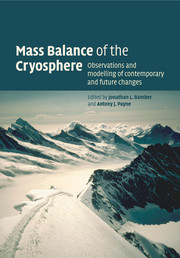Book contents
- Frontmatter
- Contents
- List of contributors
- Foreword
- Preface
- 1 Introduction and background
- Part I Observational techniques and methods
- Part II Modelling techniques and methods
- Part III The mass balance of sea ice
- Part IV The mass balance of the ice sheets
- 10 Greenland: recent mass balance observations
- 11 Greenland: modelling
- 12 Mass balance of the Antarctic ice sheet: observational aspects
- 13 Antarctica: modelling
- Part V The mass balance of ice caps and glaciers
- Index
- References
12 - Mass balance of the Antarctic ice sheet: observational aspects
Published online by Cambridge University Press: 16 October 2009
- Frontmatter
- Contents
- List of contributors
- Foreword
- Preface
- 1 Introduction and background
- Part I Observational techniques and methods
- Part II Modelling techniques and methods
- Part III The mass balance of sea ice
- Part IV The mass balance of the ice sheets
- 10 Greenland: recent mass balance observations
- 11 Greenland: modelling
- 12 Mass balance of the Antarctic ice sheet: observational aspects
- 13 Antarctica: modelling
- Part V The mass balance of ice caps and glaciers
- Index
- References
Summary
Introduction
The Antarctic ice sheet (Figure 12.1) contains sufficient ice to raise the world-wide sea level by more than 60 m if melted completely. The amount of snow deposited annually on the ice sheet is equivalent to about 5 mm of global sea level, as is the mean annual discharge of ice back into the ocean. Thus, a modest imbalance between the input and output of ice might be a major contributor to the present-day rise in sea level (1.5–2 mm per year), but the uncertainty is large.
Despite all available measurements of snow accumulation, ice velocities, surface and basal melting, and iceberg discharge, it is still not known for certain whether the ice sheet is growing or shrinking. The uncertainty in the estimate of the total mass balance is at least 20% of the mass input, equivalent to a global sea-level change of about 1 mm per year. Furthermore, the fact that rates of discharge from some of the Antarctic ice streams have changed markedly in recent decades and centuries suggests that the mass balance also may be rapidly changeable.
The volume and geographic extent of the Antarctic ice sheet certainly have undergone major changes over geological time. The ice sheet was significantly larger during the last glacial maximum (LGM), some 20 000 years ago, and retreated to near its present extent within the last several thousand years; that retreat is probably on-going at present (see Chapter 13, section 13.3.1).
- Type
- Chapter
- Information
- Mass Balance of the CryosphereObservations and Modelling of Contemporary and Future Changes, pp. 459 - 490Publisher: Cambridge University PressPrint publication year: 2004
References
- 9
- Cited by



